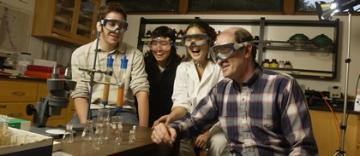
Inorganic Photochemistry Research
Much has been observed and written about compounds in solutions that react when exposed to light. Until recently though, no one was paying much attention to whether the solvent itself could also absorb light and cause a reaction.
Professor Patrick Hoggard can mark the day when his pursuit of photochemistry began in earnest. It was in 1991 and he was a professor at North Dakota State University teaching summer program undergraduates about simple chemical reactions triggered by light. Hoggard himself had already made significant contributions to the study of luminescence, an area he had specialized in almost since the beginning of his career as an inorganic chemist.
Once, one of Hoggard’s summer students stopped by the office to see him. He was helping her with experiments to study the chemical reaction of a purple solution that turned yellow when light was shined on it. She told him that something very odd was happening. The reaction was going back to purple after a while.
| “That’s the whole reason why I came to Santa Clara: to help undergraduates experience the thrill of working in an area where what they do might actually be something completely new.” |
| —PATRICK HOGGARD FLETCHER JONES PROFESSOR OF CHEMISTRY |
Hoggard did not really believe it at first. Once light is absorbed, the result may be light emission (luminescence), a chemical reaction (photochemistry), or heat. But he had never seen anything like the “round trip” she was describing. Then he observed the phenomenon himself, several times, in the lab. He found it so interesting that he convinced one of his graduate students to study what was going on for a thesis. That graduate student spent the next three years at it, as did Hoggard’s summer program undergraduates in successive years. Once they thought they understood what was going on with the reaction, a co-authored paper resulted. Hoggard sent it to a journal for publication.
“The referees all wrote back that it couldn’t be right,” Hoggard recalls, “that it just wasn’t the way these kinds of reactions happened.” He had to show them the tests they had done and their results before they too, finally accepted the findings.
Research in a New Light
Hoggard was so fascinated by what they had stumbled across that he has been searching for similar reactions ever since. They are rare, it turns out. After eight years, he and his researchers have only found five or six more—although the search is proving rich in other ways.
Reactions seem to reverse for different reasons. With some combinations, light is absorbed by the starting material and the resulting product reverses on its own, without the help of light. In other cases, changing the light’s wavelength can cause the reaction to reverse.
A reversible reaction can also occur when light is absorbed by both the starting material and the product of the reaction, as in the original discovery. “It happened almost as an accident,” Hoggard confesses. “Designing my student’s experiments, I’d picked the material, a compound of ruthenium. And I chose chloroform as the solvent just on a whim, to avoid a problem that the student had noticed with a previous solvent. The chloroform absorbed a bit of the light, underwent a reaction, then got to the compound and caused the dramatic —and unexpectedly reversible—transformation.”
So far, the search for other reversible photochemical reactions has focused on chlorinated hydrocarbon solvents, such as chloroform, which seem to be particularly good at absorbing light. But Hoggard and his researchers are interested in them for another reason too: the environment.
Chlorinated hydrocarbons are a nasty source of pollution in water supplies, especially in large farming areas where they result from the breakdown of pesticide runoff. Someday, Hoggard hopes, this research might uncover a specific compound that—reacting with pollutants, such as chloroform, and triggered just by sunlight—could degrade chlorinated hydrocarbons into more environmentally friendly byproducts, such as carbon dioxide.
Real Chemistry Here
Even if such a discovery never comes about, Hoggard is happily committed to his area of research—and to the teaching ideals of Santa Clara University, where he is the Fletcher Jones Professor of Chemistry. It was this specific work, he says, that first got him interested in coming to Santa Clara, where he knew he would be able to work more with undergraduates.
“By the time I started looking for another school, I’d had this experience working in photochemistry with undergraduates, and I had really liked it,” Hoggard says. “At large universities there can be an excessive emphasis on research, to the exclusion of teaching. I was looking for more of a balance, and Santa Clara offered it.”
Hoggard is attracted to the unbridled curiosity of undergraduates. “They aren’t stuck in the rut of a thesis,” he points out. “They’re more inclined to do things just for the heck of it, to see what results. Working with them is the most rewarding thing that I do.”